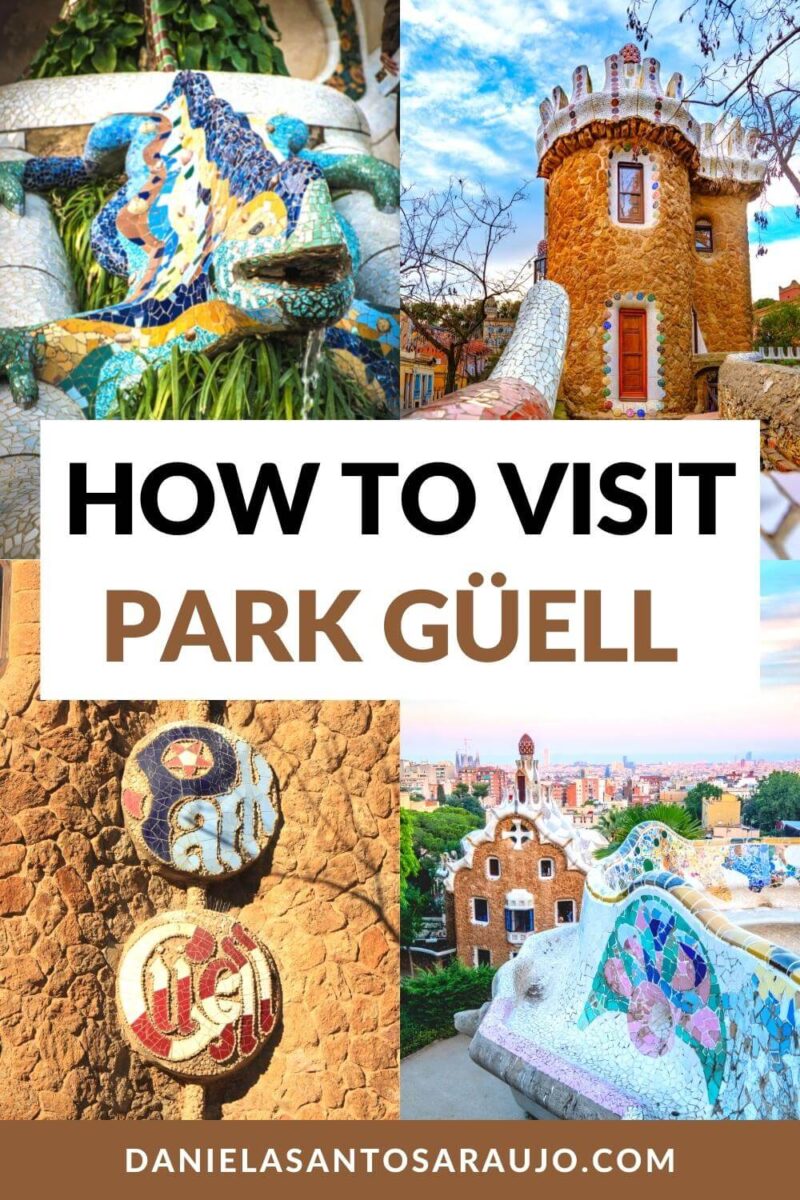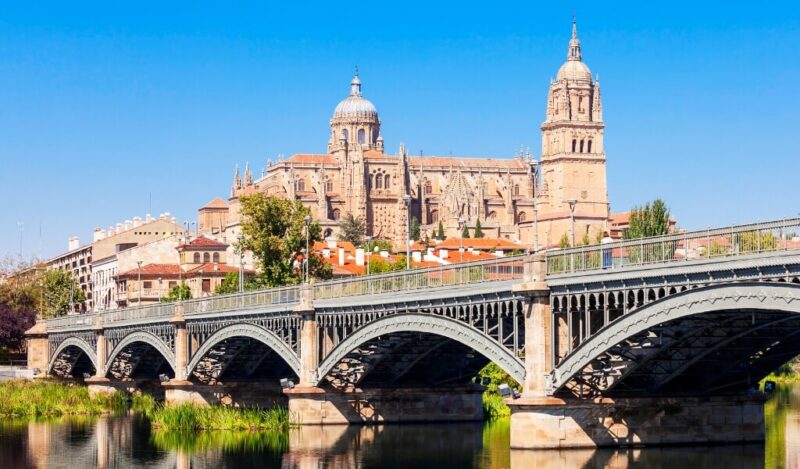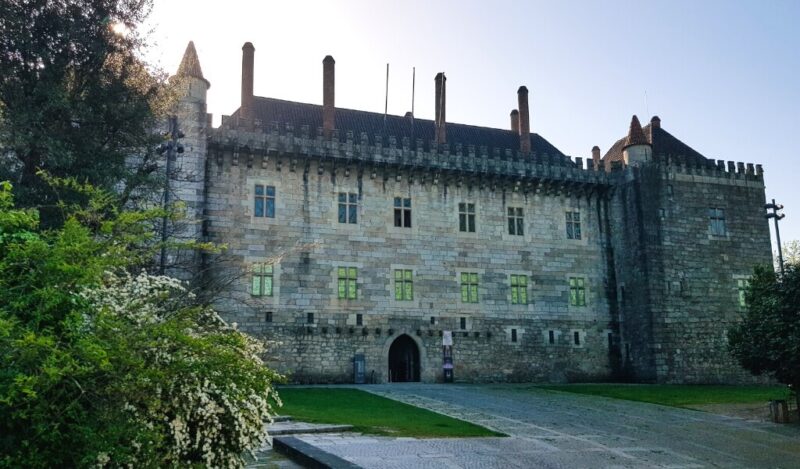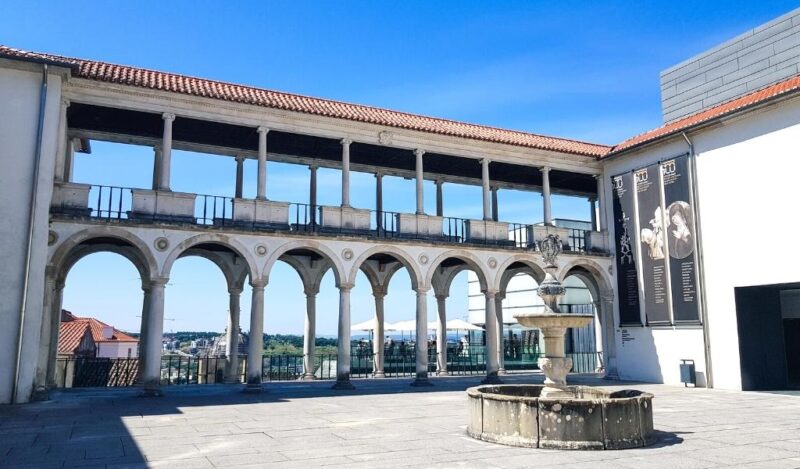Park Güell (in Catalan, Parc Güell) is a large urban park designed by Antoni Gaudí in the Gràcia district, in Barcelona. Besides, it’s one of three works by the Catalan architect distinguished with World Heritage status in 1984, to which another four were added in 2005 (all located in the province of Barcelona).
The idea for the creation of Park Güell came from Eusebi Güell, who wanted to build a luxury condominium inspired by the English concept of “garden cities”. The initial project for the enclosure had sixty houses with gardens, in addition to streets, squares, and viaducts. However, the urbanization proved to be a failure and was converted into a public park!
So, do you want to know How To Visit Park Güell In 2024? Keep reading!
This post may contain affiliate links, meaning I earn a small commission if you make a purchase, at no additional cost to you. Please read my disclosure & privacy policy for more information.
No time to read now? Pin it for later!


Brief History of Park Güell
After having lived in England, Eusebi Güell i Bacigalupi (a wealthy industrial entrepreneur) returned to his hometown of Barcelona intending to create a garden city, a concept he had heard about abroad. And the place chosen was a rocky hill in the district of Gràcia, at the time called Muntanya Pelada (ie, Bare Mountain).
To implement this urbanization, Eusebi Güell hired Antoni Gaudí i Cornet, who in turn called on his fellow architects Llorenç Matamala i Piñol, Francesc d’Assís Berenguer i Mestres, Joan Rubió i Bellver, and Josep Maria Jujol i Gibert to collaborate on the project.

Park Güell was designed as a luxury private condominium, aimed at high society families who wanted to escape the pollution, noise, and bustle of the city of Barcelona. Works began in 1900 and continued until 1914 when the First World War broke out.
Eusebi Güell realized that his idea had been a commercial failure in the early years of construction, as he had no investors interested in the residential lots of Park Güell. After the death of the businessman in 1918, the Güell family sold the land to the Municipality of Barcelona, which opened it as a public park in April of 1926.
World Heritage
Did you know that Park Güell was part of Spain’s first set of inscriptions on the UNESCO World Heritage List? This 8th session of the World Heritage Committee took place in Buenos Aires (Argentina), between October 29th and November 2nd, 1984.
Four other Spanish sites were announced in the session: Alhambra, Generalife and Albayzín, Granada; the Burgos Cathedral; the Historic Center of Cordoba; and the Monastery and Site of the Escorial in Madrid. However, Park Güell wasn’t the only work of Antoni Gaudí awarded in this session. Of a total of three works by the architect, there were also Casa Milà and the Palau Güell.
Nowadays, Spain is the fifth country in the world and the fourth country in Europe with the most UNESCO sites. It has fifty heritage assets (both cultural and natural) inscribed on the world list of the United Nations Educational, Scientific, and Cultural Organization!
In the meantime, I’ve already had the opportunity to visit ten of them:
- Alhambra, Generalife, and Albayzín, Granada (1984, 1994)
- Archaeological Ensemble of Mérida (1993)
- Archaeological Ensemble of Tarraco (2000)
- Cathedral, Alcázar and Archivo de Indias in Seville (1987)
- Historic Centre of Cordoba (1984)
- Old City of Salamanca (1988)
- Old Town of Santiago de Compostela (1985)
- Palau de la Música Catalana and Hospital de Sant Pau, Barcelona (1997)
- Paseo del Prado and Buen Retiro, a landscape of Arts and Sciences (2021)
- Works of Antoni Gaudí (1984, 2005) – Casa Batlló, Casa Milà, Casa Vicens, Crypt of Colònia Güell, Nativity Façade and Crypt of the Basilica of the Sagrada Familia, Palau Güell, and Park Güell
How to Get to Park Güell
Although Park Güell is located quite far from the historic center of Barcelona, it’s very easy to get there. This is because there are several transportation options – even though the metro and bus are the most practical:
- By metro, you can get off at the Lesseps or Vallcarca line 3 stations and do the rest on foot until the entrance to Sant Josep de la Muntanya’s Avinguda del Santuari. ATTENTION: you have to walk about 1000 meters and most of the route is uphill!
- Bus lines H6 and D40 have a relatively closer stop, on Travessera de Dalt. From there, you are just over 500 meters from the same entrance to Park Güell (there are four visitor entrances, which you can check here).
Opening Hours & Ticket Prices
Park Güell is open every day from 9:30 am, but the closing time varies depending on the month of the year, so you should confirm the exact hour on Park Güell’s official website (usually it’s between 5:30 pm and 7:30 pm).
As for tickets, these cost €10 (normal fare) or €7 (children from 7 to 12 years old). Since Park Güell is a very touristy place, I strongly recommend purchasing tickets in advance through its online ticket office, to avoid long waiting lines at the site.
What to See at Park Güell
Pavelló de Recepció & Casa del Guarda
The Reception Pavilion (in Catalan, Pavelló de Recepció) and the Guard’s House (in Catalan, Casa del Guarda) are two pavilions at the entrance of Park Güell, which function as a single exit from the enclosure since the so-called “Monumental Zone” started to be paid in 2013.
The Pavelló de Recepció was the work area of the porter of this property and was equipped with a waiting room and a telephone booth. The second was his residence (hence the name Casa del Guarda) and is now part of the MUHBA – Museu d’Història de Barcelona.

As soon as visitors arrive at Park Güell and see these two service buildings, they can immediately notice the perfect harmony between architecture and nature, a typical feature of this artistic phase of Antoni Gaudí. In my opinion, both pavilions resemble the gingerbread house of “Hansel and Gretel” (the famous fairy tale by the Brothers Grimm)!
Escala i Drac
The Staircase (in Catalan, “Escala”) is certainly one of the most photographed places in Park Güell and the city of Barcelona. What’s the reason? An animal sculpture that no one knows if it’s a salamander, a lizard, or a dragon! And you, what animal do you think is represented here?


The “Dragon” (in Catalan, “Drac”) is an integral part of a decorative fountain, whose water comes from a cistern (built under the Sala Hipòstila) and flows along with three flights of this double staircase. Another fascinating detail of the Escala is a mosaic with the emblem of Catalonia, which has an unusual spout in the shape of a snake’s head!
Sala Hipòstila
The Hypostyle Room (in Catalan, Sala Hipòstila) is a large covered space at the top of Park Güell’s staircase. Its name comes from the Greek word “hypostyle”, which means a “ceiling supported by columns”. Interestingly, some consider this to be one of Gaudí’s least creative (and interesting) works, as it’s based on forms that are too “conventional” for his style.


Antoni Gaudí conceived the Sala Hipòstila to accommodate a market. The space is made up of 86 Doric-inspired columns and a ceiling with small vaults, where white trencadís predominates. And if you look carefully at some of these domes, you’ll find polychrome mosaic “medallions” made by Josep Maria Jujol (a friend and disciple of Gaudí).
Plaça de la Natura
Nature Square (in Catalan, Plaça de la Natura) is the heart of Park Güell and one of its most famous postcards, largely because of its colorful balcony. When Antoni Gaudí designed Park Güell, he decided to incorporate a large central square, designed to host shows and other outdoor social events. For this reason, the architect called it the Greek Theater (in Catalan, Teatre Grec).

This space is also unique for another reason: unlike the rest of the park, which has been adapted to the terrain, the Plaça de la Natura is completely artificial. The farthest part (next to the Passeig de les Palmeres) was excavated from the rock that existed here, while the front section is supported by the columns of the Sala Hipòstila!
However, the element that stands out most in the Plaça de la Natura is, without a doubt, the undulating bench that serves as a balustrade and panoramic viewpoint. Designed by the architect Josep Maria Jujol, it uses prefabricated cement pieces coated with trencadís.
Passeig de les Palmeres
The Palm Trees Path (in Catalan, Passeig de les Palmeres) is the widest walkway in Park Güell, reaching up to ten meters in width!

When Eusebi Güell had the idea of building a garden city on this hill in the Gràcia district, Antoni Gaudí designed paths, roadways, and viaducts to connect the residential lots and simultaneously minimize the steep slope of the terrain.
The result is a meandering network about 3 km long, of which the Passeig de les Palmeres is the main section. Flanked by palm trees (hence the name), the walkway passes through the most iconic sites in Park Güell, such as the Pòrtic de la Bugadera, the Plaça de la Natura, the Jardins d’Àustria, and Casa Museu Gaudí.
Casa Museu Gaudí
The Gaudí House Museum (in Catalan, Casa Museu Gaudí; formerly nicknamed La Torre Rosa, that is, The Pink Tower) was one of only two buildings to be built in Park Güell (the other was Casa Trias i Domènech), despite Eusebi Güell’s initial plan to project sixty houses!
Designed by the architect Francesc Berenguer i Mestres (a friend and disciple of Gaudí), the works of La Torre Rosa lasted two years (between 1903-05) and were in charge of the contractor Josep Casanovas i Pardo and Antoni Gaudí himself.

This property was put on sale, at the same time that it served as a model house for potential buyers of the remaining plots of land in Park Güell, but it didn’t get any offer. In 1906, Gaudí eventually acquired it and lived here until 1925 – when he moved to his workshop inside the Basilica of the Sagrada Familia.
After the Catalan architect left the property in a will to the La Sagrada Familia Foundation and the latter sold it to private individuals, La Torre Rosa was restored by the Amigos de Gaudí association and opened to the public in 1963 under the name Casa Museu Gaudí. The exhibition includes personal objects by Antoni Gaudí, as well as a collection of furniture and decorative elements designed for other of his works: Casa Milà, Casa Batlló, Casa Vicens, and even the Crypt of Colònia Güell!
Jardins d’Àustria
The place where the Austria Gardens (in Catalan, Jardins d’Àustria) are located corresponded to one of the properties of the initial urbanization by Antoni Gaudí, with a house and vegetable garden. However, when Park Güell was transformed into a public park in the 1920s, this land was used as a municipal plant nursery.


In the 1960s, the green space was finally designed as a garden by the municipal architect Lluís Riutort, who designed a formal garden with parterres in the style of that time. After a donation of species from Austria in 1977, the Jardins d’Àustria gained its current name.
Pòrtic de la Bugadera
The Portico of the Washerwoman (in Catalan, Portic de la Bugadera) has this curious name because one of its columns was sculpted to imitate a woman with a laundry basket over her head.
Located on the eastern side of the Plaça de la Natura, this gallery of sloping double columns resembles a giant wave and is one of the finest examples of organic architecture idealized by Antoni Gaudí.

The Pòrtic de la Bugadera gives access to the former gardens of Casa Larrard (or Casa Muntaner de Dalt), a mansion that existed before the creation of Park Güell.
In 1906, Eusebi Güell chose Casa Larrard as his official residence, but the building was converted into a primary school in 1931. Today, it’s called Escola Baldiri Reixac.
Share this blog post on your social media!
More Posts about Spain
7 Best Museums In Barcelona (That You Should Visit This Year)
World Heritage In Castile And León (2024)
Complete Guide To The Works Of Antoni Gaudí
More Posts about Gardens and Parks
How To Visit The National Hunting Park Of Mafra In 2024
National Palace Of Queluz: Best Tips For Visiting In 2024
How To Visit The National Forest Of The Seven Hills In 2024
More Posts about World Heritage
Palace Of The Dukes Of Braganza: Best Tips For Visiting In 2024
World Heritage In Castile And León (2024)
Machado De Castro National Museum: Best Tips For Visiting In 2024
What Photography Gear Do I Use?
- Camera Body: Fujifilm X-T4 Mirrorless
- Camera Lens: Fujinon XF 18-55 mm F2.8-4 R LM OIS
- Tripod: Manfrotto Compact Action
- Small Tripod: Manfrotto PIXI Mini
- Smartphone Adaptor: Manfrotto PIXI Clamp
- Memory Card: SanDisk 128GB Extreme PRO SDXC








